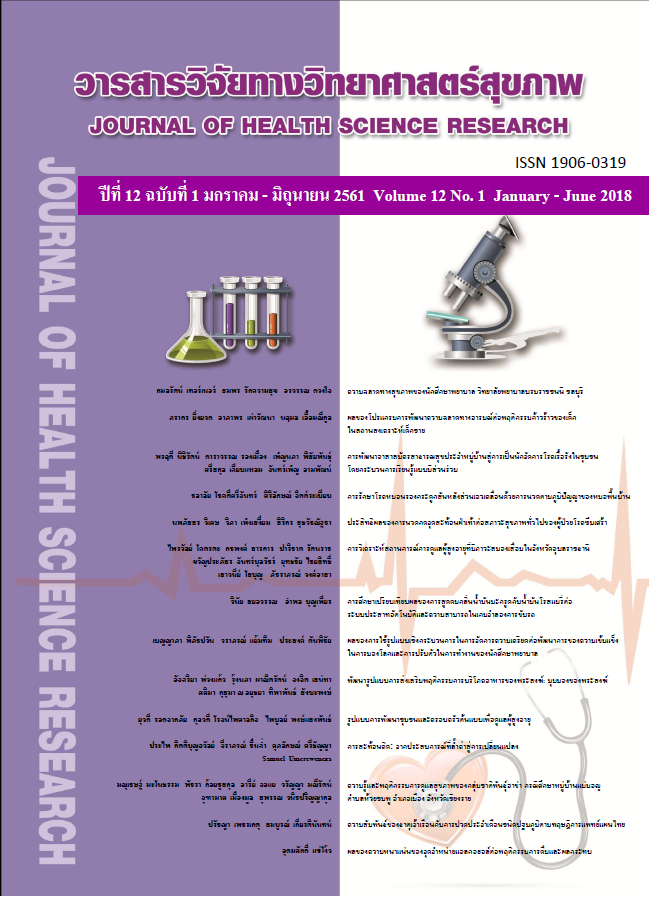ความฉลาดทางสุขภาพของนักศึกษาพยาบาล วิทยาลัยพยาบาลบรมราชชนนี ชลบุรี
Main Article Content
บทคัดย่อ
การวิจัยครั้งนี้มีวัตถุประสงค์เพื่อศึกษาความฉลาดทางสุขภาพของนักศึกษาพยาบาล วิทยาลัยพยาบาลบรมราชชนนี ชลบุรีและเปรียบเทียบความฉลาดทางด้านสุขภาพของนักศึกษาพยาบาลแต่ละชั้นปี กลุ่มตัวอย่างประกอบด้วยนักศึกษาพยาบาล วิทยาลัยพยาบาลบรมราชชนนี ชลบุรี ที่กำลังศึกษาอยู่ในชั้นปีที่ 1-4 ปีการศึกษา 2559 จำนวน 460 คน เครื่องมือที่ใช้ในการเก็บรวบรวมข้อมูล เป็นแบบสอบถามความฉลาดทางด้านสุขภาพของนักศึกษาพยาบาล จำนวน 47 ข้อ วิเคราะห์ข้อมูลโดยใช้สถิติค่าเฉลี่ย ส่วนเบี่ยงเบนมาตรฐาน และสถิติ Kruskal-Wallis test
This descriptive study was conducted to investigate health literacy of the nursing students at Boromarajonani College of Nursing, Chonburi and to compare the health literacy scores of students from different academic years. The sample was composed of 460 students undertaking baccalaureate nursing program Years 1- 4 of academic year 2016 at Boromarajonani College of Nursing, Chonburi. The self-administered questionnaire with 47 items asking about health literacy developed by the researchers was used for data collection. The data were analyzed using mean, standard deviation, and Kruskal-Wallis test.
The results showed that the mean scores of health literacy regarding health care, disease prevention, and health promotion of the nursing students at Boromarajonani College of Nursing Chonburi were in a high level ( = 4.02, SD = 0.51) with the highest mean score of health promotion ( = 4.09, SD = 0.54) and the lowest mean score of health care ( = 3.92, SD = 0.48). The senior students had highest mean score of health literacy followed by the juniors, sophomores, and freshmen, ( = 4.14, SD = 0.45; = 4.03, SD = 0.56; = 4.01, SD = 0.38; = 3.97, SD = 0.44, respectively). The lowest mean score of each year students fell in the health care category. There was no statistically significant difference among health literacy scores of students from different years. It was noted that the lowest mean scores of health literacy of the students in all levels of academic years was the health care category. This category is the foundation that health care providers need. Therefore, nursing institutions should develop strategies to increase the health literacy regarding health care aspect of the nursing students.
ผลการวิจัย พบว่านักศึกษาพยาบาล มีความฉลาดทางสุขภาพ ทั้ง 3 ด้านคือการดูแลสุขภาพ การป้องกันโรค และการส่งเสริมสุขภาพในภาพรวมอยู่ในระดับสูง ( = 4.02, SD = 0.51) ซึ่งด้านที่มีค่าเฉลี่ยสูงสุดคือด้านการส่งเสริมสุขภาพ (
= 4.09, SD = 0.54) ต่ำสุดคือด้านการดูแลสุขภาพ (
= 3.92, SD = 0.48) เมื่อพิจารณาค่าเฉลี่ยในภาพรวมทั้ง 3 ด้านของแต่ละชั้นปี พบว่า นักศึกษาชั้นปีที่ 4 มีค่าเฉลี่ยความฉลาดทางสุขภาพสูงสุด รองลงมาคือชั้นปีที่ 3, 2 และ 1 (
= 4.14, SD = 0.45;
= 4.03, SD = 0.56;
= 4.01, SD = 0.38;
= 3.97, SD = 0.44 ตามลำดับ) ผลการทดสอบความแตกต่างความฉลาดทางสุขภาพของนักศึกษาในแต่ละชั้นปีไม่มีความแตกต่างกัน ถึงแม้ความฉลาดทางสุขภาพของนักศึกษาแต่ละชั้นปีไม่มีความแตกต่างกัน แต่ด้านที่มีค่าเฉลี่ยต่ำสุดสอดคล้องกันทุกชั้นปีคือด้านการดูแลสุขภาพ ซึ่งเป็นพื้นฐานที่ผู้ให้บริการทางสุขภาพควรมี ดังนั้นสถาบันควรพัฒนากลวิธีในการเพิ่มความฉลาดทางสุขภาพ โดยเฉพาะด้านการดูแลสุขภาพสำหรับนักศึกษาพยาบาลต่อไป
Article Details
บทความที่ได้รับการตีพิมพ์เป็นลิขสิทธิ์ของวิทยาลัยพยาบาลบรมราชชนนี จังหวัดนนทบุรี
ข้อความที่ปรากฏในบทความแต่ละเรื่องในวารสารวิชาการเล่มนี้เป็นความคิดเห็นส่วนตัวของผู้เขียนแต่ละท่านไม่เกี่ยวข้องกับวิทยาลัยพยาบาลบรมราชชนนี จังหวัดนนทบุรี และคณาจารย์ท่านอื่น ในวิทยาลัยฯ แต่อย่างใด ความรับผิดชอบองค์ประกอบทั้งหมดของบทความแต่ละเรื่องเป็นของผู้เขียนแต่ละท่าน หากมีความผิดพลาดใด ๆ ผู้เขียนแต่ละท่านจะรับผิดชอบบทความของตนเองแต่ผู้เดียว

